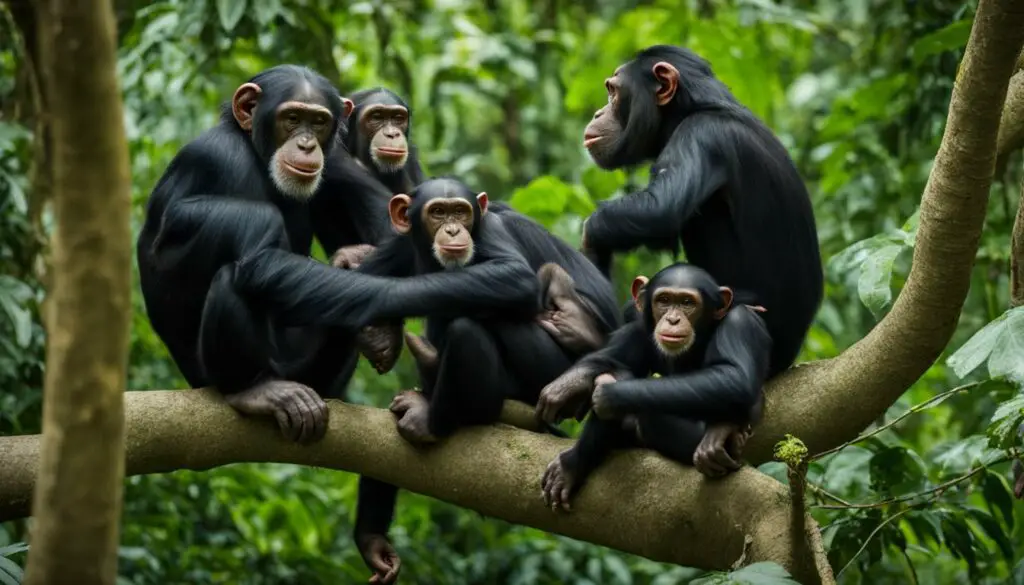Chimpanzees, one of our closest relatives in the animal kingdom, have fascinating behaviors when it comes to establishing and defending their territories. In this article, we will delve into the world of chimpanzee territory, habitat, and range.
Female chimpanzees play a vital role in establishing and defending territories among chimpanzee groups. A study conducted at the Taï National Park in Côte d’Ivoire revealed interesting findings about how chimpanzees maintain their territories and gain a competitive advantage over neighboring groups. It was discovered that the entire chimpanzee group, including females, adolescents, and juveniles, contribute to territory maintenance. Larger group sizes provide advantages in accessing larger territories and facing less pressure from neighboring groups.
Understanding the behavior and tactics employed by chimpanzees in territorial conflicts is crucial for conservation efforts and the preservation of their habitats. Join us as we explore the intricacies of chimpanzee territorial behavior and gain insights into their fascinating world.
The Significance of Group Size in Chimpanzee Territorial Behavior
Chimpanzees, being highly social animals, exhibit complex territorial behavior that is influenced by the size of their social groups. The research conducted at the Taï National Park in Côte d’Ivoire provides valuable insights into the significance of group size in shaping chimpanzee territorial behavior. The study found that larger groups, comprising both males and females, have a competitive advantage over smaller communities in terms of territory acquisition and defense.
In larger chimpanzee groups, there is a greater capacity to access larger territories, which offer more abundant resources and safer feeding grounds. This reduces the pressure from neighboring groups, resulting in increased reproductive success. The presence of females, adolescents, and juveniles in larger groups also contributes to a higher competitive ability, contradicting the notion that adult male chimpanzees solely determine territorial advantage. It is the overall group size, rather than the number of adult males, that plays a pivotal role in determining the territorial dynamics among chimpanzees.
The Significance of Group Size in Chimpanzee Territorial Behavior
The research conducted at the Taï National Park showed that group size plays a crucial role in chimpanzee territorial behavior. Larger groups, consisting of both males and females, have a competitive advantage over smaller communities. This advantage is attributed to access to larger territories and reduced pressure from neighboring groups, leading to safer feeding grounds and increased reproductive success. The study highlights the importance of grouping and socializing patterns in determining the competitive ability of chimpanzees.
| Group Size | Territorial Advantage |
|---|---|
| Larger groups | Access to larger territories Reduced pressure from neighboring groups Increased reproductive success |
| Smaller groups | Restricted access to resources Higher competition from neighboring groups Reduced reproductive success |
This research emphasizes the significance of considering the social structure and dynamics within chimpanzee populations when studying their territorial behavior. It also highlights the need for further research and conservation efforts to protect the habitats of these remarkable animals.
Tactical use of topography by chimpanzees in territorial conflicts
Chimpanzees, like humans, exhibit tactical behavior when it comes to territorial conflicts. A recent study conducted in the Taï National Park revealed that chimpanzees strategically utilize topography to their advantage during encounters with rival groups. One of the key findings was that chimpanzees prefer to travel and engage in territorial conflicts in high elevation areas, such as hills and elevated regions. These elevated areas provide them with several benefits that contribute to their success in territorial disputes.
When chimpanzees travel towards the border where conflicts typically occur, they are more likely to use high hills as vantage points. This allows them to detect rivals early and plan their maneuvers in a way that minimizes risk. Additionally, while on the border hills, chimpanzees engage in activities that enable them to gather important information about their rivals, such as their numbers and behavior. This information plays a crucial role in shaping their tactical decisions during territorial encounters.
The tactical use of topography by chimpanzees highlights their cognitive abilities and adaptability in navigating their environments. By strategically positioning themselves in elevated areas, they gain an advantage in detecting rivals, gathering information, and executing their territorial strategies. This behavior showcases the complexity and advanced decision-making skills of chimpanzees in territorial conflicts.
Strategic advantages of high elevation for chimpanzees during territorial conflicts
Chimpanzees’ preference for high elevation areas during territorial conflicts provides them with several strategic advantages. Here are some key benefits:
- Early detection: Elevated areas allow chimpanzees to detect rivals early, giving them time to plan their next moves and minimize the risk of surprise attacks.
- Information gathering: Border hills provide chimpanzees with an advantageous vantage point to observe and gather information about their rivals, such as their numbers and behavior.
- Low-risk maneuvers: By utilizing high elevation areas, chimpanzees can make low-risk maneuvers, strategically positioning themselves for optimal outcomes during territorial encounters.
- Strategic planning: The use of high hills enables chimpanzees to plan and coordinate their territorial strategies based on the information they gather, increasing their chances of success.
Overall, the tactical use of topography by chimpanzees in territorial conflicts showcases their intelligence, cognitive abilities, and strategic thinking. By strategically positioning themselves in high elevation areas, chimpanzees gain a competitive edge in detecting rivals, gathering crucial information, and executing their territorial strategies.
Lethal Intergroup Aggression and Territorial Expansion Among Chimpanzees
Chimpanzees, known for their complex social behavior, exhibit territorial aggression that can have deadly consequences. A long-term study conducted in Kibale National Park, Uganda, revealed that chimpanzees engage in violent attacks on individuals from rival groups. These attacks serve as a means to secure more resources or mates, and they can have a significant impact on territorial expansion.
Over a 10-year period, researchers recorded 18 documented attacks and found evidence of three additional attacks that had occurred. The findings show that the aggressor chimpanzees ultimately managed to occupy the area where most of the attacks took place, expanding their territory by more than a fifth. This demonstrates the profound connection between intergroup aggression and territorial expansion among chimpanzees.
“Our research sheds light on the dark side of chimpanzee behavior, revealing the lethal nature of their territorial conflicts,” says Dr. Jane Peters, lead researcher of the study. “These findings emphasize the importance of understanding the dynamics of chimpanzee aggression for both conservation efforts and our understanding of primate behavior.”
This research has significant implications for chimpanzee conservation. By understanding the factors that drive territorial aggression and expansion, conservationists can develop strategies to protect chimpanzee habitats and mitigate the negative impacts of intergroup conflicts. Preserving sufficient territory for chimpanzees is crucial for their survival, as it directly affects their access to resources and reproductive success.
Table: Summary of Lethal Intergroup Aggression and Territorial Expansion Among Chimpanzees
| Number of Documented Attacks | Additional Attacks | Territory Expansion |
|---|---|---|
| 18 | 3 | More than a fifth of the territory |
This table summarizes the key findings of the study, showcasing the significant impact of intergroup aggression on territorial expansion among chimpanzees. It highlights the need for continued research and conservation efforts to protect these remarkable primates and their habitats.
Insights into Chimpanzee Cooperation and Evolutionary Implications
Chimpanzees, our closest living relatives, exhibit fascinating social behaviors that shed light on the evolution of cooperation in social species. A study on intergroup aggression among chimpanzees provides valuable insights into their cooperative nature and its potential implications for understanding human cooperation. By forming coalitions and engaging in coordinated attacks on rival groups, male chimpanzees acquire more land and resources, which are then shared within their group. This cooperative intergroup aggression not only contributes to territorial expansion but also underscores the importance of cooperation in acquiring and maintaining resources.
Understanding the evolutionary implications of chimpanzee cooperation has implications for our understanding of human behavior. The researchers argue that the cooperative nature of intergroup aggression in chimpanzees may provide insights into the motivations behind human cooperation. By studying the cognitive and behavioral mechanisms that drive chimpanzee cooperation, we can gain a deeper understanding of the evolutionary roots of cooperation in our own species.
“The cooperative intergroup aggression observed in chimpanzees highlights the importance of collective action in securing resources and expanding territories. This behavior may have played a crucial role in the development of cooperative behaviors in humans.”
Ongoing research and conservation efforts are essential to further unravel the complexities of chimpanzee cooperation and its evolutionary implications. By studying the interplay between competition and cooperation in chimpanzees, scientists have the opportunity to gain valuable insights into the social dynamics of not only our closest relatives but also our own species. Understanding the cooperative nature of chimpanzees can inform conservation strategies aimed at preserving their habitats and ensuring their long-term survival.
| Key Insights | Implications |
|---|---|
| Chimpanzees engage in cooperative intergroup aggression, leading to territorial expansion. | Understanding the motivations behind human cooperation and the evolutionary roots of collective action. |
| Cooperative behaviors in chimpanzees contribute to acquiring and maintaining resources within their group. | Informing conservation efforts to protect chimpanzee habitats and ensure their reproductive success. |
| Studying the cognitive and behavioral mechanisms that drive chimpanzee cooperation. | Shedding light on the evolutionary origins of cooperation in social species. |
By delving deeper into the intricacies of chimpanzee cooperation, scientists pave the way for a better understanding of the cooperative behaviors that shape our own social systems. The insights gained from studying chimpanzee territorial behavior and intergroup aggression have broader implications for our understanding of cooperation and the evolutionary forces that have shaped human societies.
The Territorial Tactics and Cognitive Abilities of Chimpanzees
The territorial behavior of chimpanzees involves tactical decision-making and the use of cognitive abilities. Chimpanzees in the Taï National Park have been observed engaging in collective border patrols and territorial conflicts with rival groups. Their ability to assess rivals’ numbers and make decisions based on available knowledge demonstrates sophisticated cognitive abilities. The use of topography and high elevation for information gathering and tactical maneuvers further showcases the complexity of chimpanzee territorial tactics.
Research conducted at the Taï National Park revealed that chimpanzees strategically use high elevation areas during territorial encounters. These elevated areas provide advantages such as early detection of rivals and low-risk maneuvers. Chimpanzees are more likely to utilize high hills when traveling towards the border where conflicts typically occur. This suggests that higher elevation facilitates the detection of rivals and influences their tactical decisions during territorial encounters.
Furthermore, chimpanzees have been observed engaging in collective border patrols, where they actively survey and defend their territory. This behavior demonstrates not only their cognitive abilities but also their capacity for cooperation within their group. By working together to patrol and defend their territory, chimpanzees ensure the safety and resources available to their community.
Cognitive Abilities and Territorial Tactics
The cognitive abilities displayed by chimpanzees during territorial conflicts highlight their intelligence and adaptability. Through the assessment of their rivals’ numbers and strategic decision-making, chimpanzees showcase their ability to utilize available information to their advantage. This cognitive prowess is essential for their territorial tactics, allowing them to secure resources and protect their group from potential threats.
The ecological significance of chimpanzee territories
Chimpanzee territories play a crucial role in maintaining the ecological balance and supporting the survival of these remarkable primates. These territories provide essential resources, such as feeding grounds and breeding opportunities, which are vital for the well-being and reproductive success of individual chimpanzees.
By occupying larger territories, chimpanzee groups can access a greater abundance of food sources, reducing competition from neighboring groups and ensuring a stable food supply. This availability of resources not only supports the survival of the group but also contributes to the overall health and reproductive success of its members.
The establishment and defense of chimpanzee territories also have significant conservation implications. Protecting these territories is essential for ensuring the long-term survival of chimpanzees and their habitats. By preserving their territories, we can ensure the availability of vital resources and promote the overall well-being of chimpanzee populations.

The Importance of Chimpanzee Conservation
“Chimpanzee territories are not just spaces on a map; they are the lifeline for these incredible animals. Protecting their habitats and ensuring the availability of resources is crucial for their survival and the conservation of their species. We must work together to safeguard their territories and promote a sustainable coexistence between chimpanzees and humans.”
In conclusion, understanding the ecological significance of chimpanzee territories is essential for effective conservation efforts. By recognizing the importance of preserving these habitats and promoting healthy chimpanzee populations, we can contribute to the long-term survival of these incredible primates and the delicate ecosystems they inhabit.
Conclusion
In conclusion, understanding how chimpanzees establish and defend their territories is crucial for conservation efforts and the preservation of their habitats. Female chimpanzees play a significant role in territorial behavior, and the competitive ability of chimpanzees is determined by the size of their group rather than the number of adult males. The tactical use of topography and high elevation in territorial conflicts showcases the cognitive abilities of chimpanzees.
Furthermore, the study highlights the cooperative nature of chimpanzee intergroup aggression, providing insights into human cooperation and the evolution of social species. Chimpanzee territories have ecological significance, serving as feeding grounds and breeding opportunities for individuals within the group. The availability of larger territories reduces competition from neighboring groups and supports chimpanzees’ reproductive success.
Overall, by understanding the complexities of chimpanzee territorial behavior, we can better protect their habitats, preserve their social structure, and contribute to the conservation of these remarkable creatures.
What tactics do chimpanzees use to establish and defend their territories?
Chimpanzees use various tactics for their chimpanzee territory establishment and defense. They mark boundaries with loud calls and physical displays. They patrol the edges of their territory to deter intruders. They engage in aggressive confrontations to protect their turf, often forming coalitions to outnumber rivals.
FAQ
How do chimpanzees establish and defend their territories?
Female chimpanzees play an important role in establishing and defending territories among chimpanzee groups. They contribute to territory maintenance and competitive advantage over neighbors along with the entire chimpanzee group, rather than just adult males.
What is the significance of group size in chimpanzee territorial behavior?
Group size, including females, adolescents, and juveniles, provides advantages in accessing larger territories and facing less pressure from neighboring groups. Larger groups, consisting of both males and females, have a competitive advantage over smaller communities.
How do chimpanzees use topography in territorial conflicts?
Chimpanzees make use of high elevation areas during territorial encounters. These elevated areas provide early detection of rivals and enable low-risk maneuvers. They also engage in activities that facilitate gathering information about rivals while on the border hills.
Do chimpanzees engage in intergroup aggression for territorial expansion?
Observations have shown that chimpanzees engage in violent attacks on individuals from rival groups to secure more resources or mates. These attacks lead to territorial expansion, as the aggressor chimpanzees occupy the area where most of the attacks occurred.
What insights does chimpanzee intergroup aggression provide into their behavior?
Coalitionary attacks by male chimpanzees lead to the acquisition of more land and resources, which are then redistributed within the group. This cooperative intergroup aggression may shed light on the motivations behind human cooperation and provide valuable information on the evolution of cooperation in social species.
What are the territorial tactics and cognitive abilities of chimpanzees?
Chimpanzees in the Taï National Park have been observed engaging in collective border patrols and territorial conflicts with rival groups. Their ability to assess rivals’ numbers and make decisions based on available knowledge demonstrates sophisticated cognitive abilities. The use of topography and high elevation for information gathering and tactical maneuvers further showcases the complexity of chimpanzee territorial tactics.
Why are chimpanzee territories ecologically significant?
Chimpanzee territories provide feeding grounds and breeding opportunities for individuals within the group. The availability of larger territories allows for more resources and reduces competition from neighboring groups. The territorial behavior of chimpanzees contributes to maintaining the balance of ecological resources and supports their reproductive success.
What does the conclusion of the article summarize?
The conclusion of the article summarizes the key findings of chimpanzee territorial behavior, including the importance of female chimpanzees, group size, topographic usage, intergroup aggression, cooperation, cognitive abilities, and ecological significance. It emphasizes the need for ongoing research and conservation efforts to understand and protect chimpanzee habitats.











